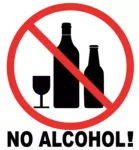
It’s not helpful to try to scare your teen with erroneous information, such as saying vaping causes cancer, which hasn’t been proven. Start, instead, with a focus on the addictive nature of nicotine. “Parents who have candid conversations with their kids can really make a difference,” says Suchitra Krishnan-Sarin, PhD, who directs TCORS. Parents who engage their children in conversation can actually help protect them against future substance use, she adds. When it comes to vaping, “it’s not a matter of if your child will get asked, but when,” Dahl says. Students have told her about the intense peer pressure they’re under to try vaping.
Help your teen find positive peer groups
This resource guide for parents offers advice on keeping children substance free. Review statistics about adolescent substance use, and learn tips on good communication. The guide also features substance facts and case studies for additional insight.

Staying Social When You Quit Drinking
A total of 1,010 adult daily smokers were involved in the trial, with 505 receiving the free vapes in A&E. Lead author Dr. Emma Ward, from UEA’s Norwich Medical School, said, “There is a school of thought that vapes should only be available on prescription. Fourteen athletes tell their real stories about how vaping negative impacted their athletic performance how to deal with peer pressure and future opportunities. Setting the right tone can make a big difference in how well the conversation goes. You don’t need to make the conversation seem like a big deal by pulling your child into the dining room for a formal chat. If the cravings come with other withdrawal symptoms, such as headaches and hunger, staying hydrated can help.
My Vaping Mistake: Videos of Real Teen Experiences
Thinking of it as an ongoing conversation also gives you both time to research and learn more between discussions. First, it’s helpful to understand why your child is vaping to start with. Although many people initially use nicotine to find relief from anxiety or depression, they quickly discover that addiction can develop. And that addiction can take a damaging toll on your mood and health.
VAPING RESOURCES FOR TEENS & FAMILIES
As you just learned, there is a lot to know about vaping. To best inform yourself and protect your child, get the facts concerning the signs, symptoms, dangers, and what is behind the epidemic. I know it can be tempting if your friends are vaping and offer to share it with you. What might you do or say if your friends offer to vape with you? Use tips in this guide and our Get The Facts page to help as you prepare.
Now if parents want to know if their teens are vaping nicotine or cannabis, their best bet is a good old fashioned conversation. As many parents know, teens often don’t want to listen or talk about tough topics like vaping. But having these conversations is crucial to your child’s health and well-being.
- “Many of them started vaping thinking it was just great flavors and water vapor. They certainly didn’t sign up to become addicted.”
- If you’re in need of in-the-moment support you can contact Childline, where you can speak to a counsellor.
- Volunteer opportunities can also alleviate boredom, boost self-esteem, and help foster a sense of direction.
- You might want to mention how vaping affects the teeth and gums, as well as the potential for nicotine addiction.
- According to a CDC study, roughly 99 percent of e-cigarettes sold in the U.S. have some level of nicotine, and the content isn’t always disclosed.
- In a 2021 U.S. survey, more than two million middle and high school students said they had used electronic or e-cigarettes within the past month.
If you’re stressed or anxious:

They get asked in the bathrooms at school, behind the stadium at Friday football games, on the bus on the way to a tennis match. But the friend of Dahl’s sons had a good reason to be thinking about vaping in her presence. Earlier that month, he’d attended one of her talks about vaping health risks.
- If social pressure is a trigger, take a break from friends who vape or let them know you’re trying to quit.
- Once you have some talking points and ideas, rehearse them with someone you trust who can give honest feedback on how you are actually coming across, Lebowitz says.
- Incentives can work well to curb vaping behavior too—positive reinforcement is a tried and true method of behavioral change.
- As you talk to your child, avoid judgment or frustration.

If you use both e-cigarettes and traditional cigarettes, you further increase your health risks. One study found that people who use both types of nicotine sources significantly raise their odds of cardiovascular disease. Vaping involves inhaling the vapor from an e-cigarette, e-pipe, vape pod, vape pen, or similar device. Many kids and teens look at vaping and see a harmless activity. You might think that it’s essentially just flavored steam that helps you relax.
Helping Someone with a Drug Addiction
For more stories about your life and health, explore Life Kit, NPR’s family of podcasts for making life better — everything from exercise to raising kids to making friends. For more, sign up for the newsletter and follow @NPRLifeKit on Twitter. This fact sheet relates to the public service announcement from SAMHSA’s “Talk. They Hear You.” campaign sharing relevant facts about the campaign’s history and focus on alcohol and other drugs, such as marijuana and opioids.





